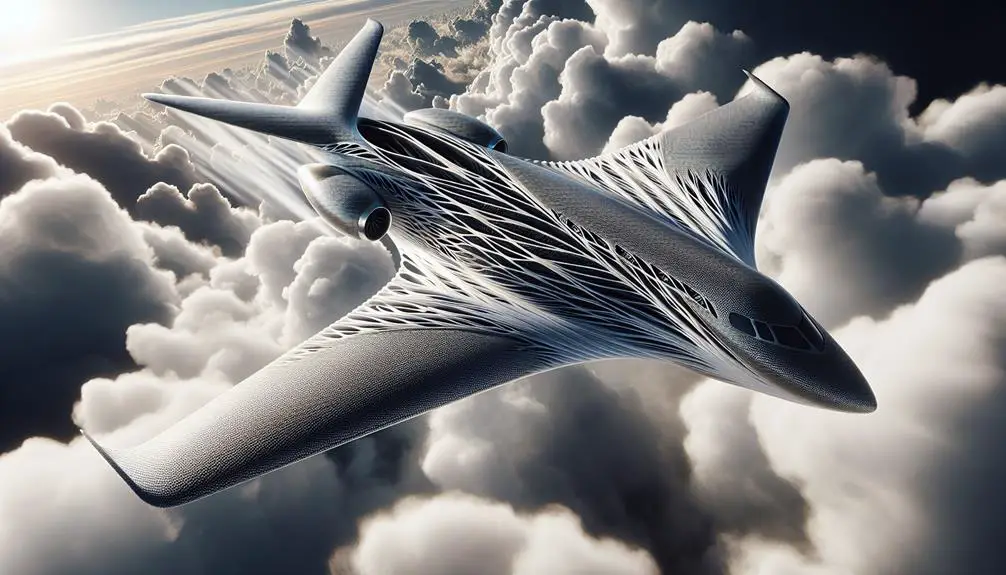Imagine the fabric of space exploration woven with threads of innovation and resilience. When you're selecting materials for aerospace applications, it's crucial to ponder factors like strength, heat resistance, and durability. Kevlar, for instance, offers unmatched protection, while Nomex excels in high-temperature environments. But have you pondered the unique advantages of Basalt Fiber? This eco-friendly material combines high tensile strength with thermal stability, making it a compelling option. To truly grasp which fabric suits your needs, you'll want to explore how each performs under the demanding conditions of aerospace applications.
Table of Contents
Key Takeaways
- Kevlar: Offers exceptional strength, durability, and impact resistance, making it ideal for aerospace components needing high resilience.
- Basalt Fiber: Provides high tensile strength, thermal stability, and eco-friendly properties, suitable for sustainable aerospace applications.
- Aramid Fibers: Known for toughness, heat resistance, and impact resilience, commonly used in aircraft components and ballistic protection.
- Carbon Fiber: Lightweight yet strong, with high tensile strength and corrosion resistance, tailored for demanding aerospace structures.
- Nomex: High-temperature and fire resistance, essential for aerospace applications requiring protective and conductive textiles.
Kevlar: The Ultimate Protector
When it comes to aerospace applications, Kevlar stands out as the ultimate protector due to its exceptional strength and durability. You can't overlook its unparalleled impact resistance, which is crucial for guaranteeing the safety and longevity of aerospace components. This remarkable fabric absorbs and disperses energy efficiently, making it a top choice for materials subjected to high-impact forces.
Kevlar's ballistic protection further underscores its importance in the aerospace industry. In environments where the risk of high-velocity projectiles is a constant concern, Kevlar provides a robust shield. You'd find it used extensively in aircraft armor, cockpit linings, and even in the protective gear for aerospace personnel. Its lightweight nature doesn't compromise its protective qualities, making it ideal for applications where weight is a critical factor.
Moreover, Kevlar's durability assures it withstands the rigors of harsh aerospace conditions over extended periods. This means fewer replacements and repairs, ultimately reducing downtime and costs.
Nomex: High-Temperature Resistance
When you need a fabric that can withstand extreme heat, Nomex stands out with its exceptional thermal insulation properties.
It doesn't just resist fire; it actively protects against it, ensuring safety in high-risk environments.
Plus, its durability under stress makes it a reliable choice for demanding aerospace applications.
Thermal Insulation Properties
Nomex's exceptional high-temperature resistance makes it a top choice for thermal insulation in aerospace applications. When you're designing for extreme conditions, Nomex guarantees that your creations stand up to the heat. Its ability to maintain structural integrity under high temperatures means you can rely on it in critical aerospace components.
Integrating conductive textiles with Nomex opens the door to innovative designs that not only insulate but also manage electrical currents efficiently.
Reflective materials paired with Nomex can enhance thermal protection, making it essential for space exploration opportunities. These reflective layers bounce back radiant heat, ensuring that spacecraft and suits remain insulated from the intense thermal radiation encountered in space. By combining Nomex with such materials, you create a barrier that excels in both insulation and reflection.
Understanding the thermal insulation properties of Nomex allows you to push the boundaries of aerospace engineering. Its high-temperature resistance, combined with the potential for conductive and reflective enhancements, offers a versatile solution for your most demanding projects.
Don't overlook the strategic advantage Nomex provides—it's a cornerstone for developing the next generation of aerospace materials. Embrace these properties, and elevate your designs to new heights.
Fire-Resistant Capabilities
Beyond its thermal insulation properties, Nomex's fire-resistant capabilities make it indispensable in aerospace applications. When you're dealing with the intense conditions of space and high-speed flight, fire safety is non-negotiable. Nomex, an advanced technology fabric, provides unparalleled thermal protection, safeguarding both passengers and crew.
Nomex doesn't just resist flames; it thrives in high-temperature environments where other materials would fail. This innovative material is engineered to withstand temperatures up to 400°F (204°C) without melting. Its inherent fire-resistant properties guarantee that it doesn't ignite, drip, or support combustion, which is critical for maintaining safety standards in aerospace contexts.
Here's a quick comparison to help you understand Nomex's unique advantages:
| Feature | Nomex |
|---|---|
| Melting Point | Does not liquefy |
| Ignition Resistance | High |
| Thermal Stability | Up to 400°F (204°C) |
| Combustion Support | Does not facilitate |
Durability Under Stress
Durability under stress is a hallmark of Nomex, especially when exposed to high temperatures. Nomex's high-temperature resistance makes it indispensable in aerospace applications where thermal management is pivotal. When subjected to extreme conditions, Nomex maintains its structural integrity, offering you unparalleled reliability.
You need a fabric that not only withstands heat but also resists impact. Nomex excels here, providing exceptional impact resistance, guaranteeing the safety and durability of aerospace components.
In high-stress environments, the balance between flexibility and strength is crucial. Nomex delivers on both fronts. Its unique molecular structure allows it to bend without breaking, adapting to varying stress loads while maintaining its form. This flexibility ensures even weight distribution, which is essential in aerospace design to prevent structural failures.
Moreover, Nomex's lightweight nature doesn't compromise its durability. You'll appreciate how it contributes to overall weight reduction in aerospace structures, enhancing fuel efficiency and performance. By integrating Nomex into your designs, you leverage a fabric that not only endures high temperatures but also supports the rigorous demands of aerospace applications.
Essentially, Nomex offers a robust solution for maintaining the structural integrity and performance of your aerospace endeavors.
Carbon Fiber: Lightweight Strength
Carbon fiber offers unparalleled lightweight strength, making it a top choice for aerospace applications. When you explore carbon fiber manufacturing, you'll see how its unique properties are tailored for high-performance demands. This composite material combines the high tensile strength of carbon atoms with a lightweight matrix, creating an ideal fabric for structural components in aircraft and spacecraft.
By integrating carbon fiber into aerospace applications, you achieve remarkable strength-to-weight ratios, essential for enhancing fuel efficiency and payload capacity. The manufacturing process involves precisely aligning carbon fibers within a resin matrix, ensuring optimal strength and durability.
| Feature | Benefit |
|---|---|
| High Tensile Strength | Enhanced structural integrity |
| Lightweight | Improved fuel efficiency |
| Corrosion Resistance | Reduced maintenance costs |
| Thermal Stability | Reliable performance in extremes |
These advantages make carbon fiber an indispensable material in the aerospace industry. Its high tensile strength ensures that structural integrity is maintained under extreme stresses, while its lightweight nature notably reduces the overall weight of the aircraft. Additionally, carbon fiber's corrosion resistance minimizes maintenance, and its thermal stability ensures reliable performance even in the most challenging environments. By mastering the use of carbon fiber, you position yourself at the forefront of aerospace innovation.
Fiberglass: Versatile and Durable
Fiberglass stands out as a versatile and durable material, making it an excellent choice for various aerospace applications. When you consider the myriad of fiberglass applications, you'll find it used extensively in aircraft interiors, radomes, and even structural components. Its ability to be molded into innovative designs allows for greater flexibility and creativity in engineering solutions.
One of the core durability benefits of fiberglass in the aerospace industry is its resistance to corrosion and extreme temperatures. Unlike metals, fiberglass doesn't rust or degrade when exposed to harsh environmental conditions, which is pivotal for maintaining the integrity of aerospace components over time. Additionally, fiberglass offers excellent fatigue resistance, ensuring that it can withstand the repetitive stresses encountered during flight operations without compromising performance.
You'll also appreciate that fiberglass is relatively lightweight compared to traditional materials. This weight advantage translates to improved fuel efficiency, which is a significant benefit in an industry where every pound counts. By incorporating fiberglass into your designs, you can achieve a balance between weight savings and structural integrity, ensuring that your aerospace applications meet stringent safety and performance standards.
Choosing fiberglass means opting for a material that delivers both versatility and durability, essential for pushing the boundaries of aerospace innovation.
Vectran: High Tensile Strength
Among the high-performance materials used in aerospace, Vectran stands out for its impressive tensile strength. You'll find its applications and innovative uses throughout the industry, particularly in scenarios where strength and reliability are paramount.
Vectran, a liquid crystal polymer fiber, offers remarkable high tensile strength benefits that are indispensable in aerospace engineering. Its strength-to-weight ratio is higher than steel, which means you get unparalleled durability without the weight penalty.
In aerospace engineering, Vectran applications include reinforcement of inflatable structures, tether lines for satellites, and even protective gear for astronauts. These innovative uses leverage Vectran's ability to withstand high stress and strain, ensuring safety and performance.
By incorporating Vectran into your designs, you're not just enhancing strength; you're also improving the overall efficiency and longevity of the components.
Moreover, Vectran's resistance to chemicals and moisture makes it ideal for harsh space environments. It doesn't just excel in tensile strength but also maintains its properties under extreme conditions.
PBO: Extreme Heat Resistance
When you're addressing aerospace applications necessitating extreme heat resistance, PBO (polybenzoxazole) stands out as an unparalleled choice. Renowned for its extreme durability and heat resistance, PBO is a high-performance textile that excels in the demanding conditions typical of aerospace environments. Its unique molecular structure allows it to withstand temperatures that would cause other materials to fail, making it indispensable for critical aerospace applications.
You'll find that PBO's extreme durability isn't just about surviving high temperatures. This fabric also resists abrasion and chemical degradation, guaranteeing that it maintains its integrity over extended periods of use. This makes PBO an ideal material for components like heat shields, protective gear, and other high-stress aerospace applications where maintaining performance is non-negotiable.
Moreover, PBO's heat resistance is complemented by its impressive strength-to-weight ratio. In aerospace, where every ounce matters, PBO's lightweight yet robust nature contributes to fuel efficiency and overall performance.
Whether you're designing spacecraft, high-altitude drones, or satellite components, integrating PBO into your materials toolkit ensures that your projects satisfy the stringent demands of modern aerospace engineering.
Ceramic Matrix Composites
You'll appreciate Ceramic Matrix Composites for their incredible high-temperature resistance, making them ideal for aerospace applications.
These materials not only offer enhanced structural integrity but also maintain lightweight durability.
With these qualities, you can achieve superior performance in demanding environments.
High-Temperature Resistance
Ceramic matrix composites (CMCs) offer exceptional high-temperature resistance, making them ideal for aerospace applications. When you're engineering high-performance aircraft or spacecraft, you need materials that can withstand extreme thermal stress. CMCs excel in this area, providing superior heat shield materials.
With innovative designs, these composites can protect critical components from the intense heat generated during re-entry into the Earth's atmosphere or high-speed flight.
By incorporating thermal barrier coatings, you can further enhance the capability of CMCs to endure extreme temperatures. This cutting-edge technology involves applying a thin layer of ceramic material to the surface of the composite, creating an additional barrier against heat. This not only improves the thermal resistance but also increases the longevity of the component by reducing oxidation and wear.
If you're seeking to push the boundaries of aerospace engineering, leveraging the high-temperature resistance of CMCs is essential. These materials allow for more efficient and robust designs, enabling aircraft and spacecraft to operate safely under the most demanding conditions.
Mastering the use of CMCs and their thermal management capabilities will significantly enhance the performance and reliability of your aerospace projects.
Enhanced Structural Integrity
In aerospace engineering, leveraging Ceramic Matrix Composites (CMCs) boosts structural integrity, ensuring components remain robust under extreme conditions. You'll find that CMCs not only provide enhanced flexibility but also improve reliability to a great extent. This combination is essential for aerospace applications where the stakes are high, and performance can't be compromised.
CMCs offer several advantages that contribute to overall enhanced performance and increased safety:
- High resistance to thermal shock: CMCs can withstand rapid temperature changes, which is important during launch and re-entry phases.
- Superior wear resistance: These materials maintain their structural integrity over longer periods, reducing the need for frequent replacements.
- Lightweight properties: Despite their robustness, CMCs are lighter than traditional metals, which contributes to fuel efficiency and payload capacity.
- Corrosion resistance: They resist oxidation and chemical degradation, ensuring longevity even in harsh environments.
Lightweight Durability
Among the many benefits of Ceramic Matrix Composites (CMCs), their lightweight durability stands out as a game-changer for aerospace applications. When you're looking to optimize aircraft performance, CMCs offer an unparalleled combination of strength and lightness.
These composites exhibit exceptional impact resistance, ensuring that your aircraft can withstand various stresses without compromising structural integrity.
You'll appreciate how CMCs deliver flexible strength. Unlike traditional materials that may be either too rigid or too weak, CMCs strike the perfect balance, adapting to dynamic forces while maintaining their form. This flexibility is essential when dealing with the extreme conditions of aerospace environments.
Additionally, CMCs boast superior abrasion and tear resistance. It means you can rely on these materials to endure harsh operational conditions, reducing the need for frequent repairs or replacements.
This durability translates to longer service life and reduced maintenance costs, vital factors for any aerospace project aiming for efficiency and reliability.
Basalt Fiber: Natural Strength
When you need exceptional strength and thermal resistance in aerospace applications, basalt fiber stands out as a natural and reliable choice. Derived from volcanic rock, basalt fiber offers impressive mechanical properties while remaining an eco-friendly option. As a sustainable alternative to traditional materials, basalt fiber excels in various demanding aerospace scenarios.
You'll find basalt fiber's benefits invaluable:
- High tensile strength: Comparable to carbon and glass fibers, basalt fiber can withstand extreme stress without compromising integrity.
- Thermal stability: It retains its properties in high-temperature environments, making it ideal for components exposed to intense heat.
- Corrosion resistance: Unlike metals, basalt fiber resists chemical and environmental degradation, ensuring long-lasting performance.
- Eco-friendly applications: With minimal environmental impact during production, basalt fiber is a greener choice for your projects.
From reinforcing aircraft structures to improving the durability of composite materials, basalt fiber's versatility is unmatched. Its natural origin means you're opting for a material that aligns with sustainability goals without sacrificing performance.
When you're selecting fabrics for aerospace applications, basalt fiber's combination of strength, durability, and environmental benefits guarantees your projects meet the highest standards. By choosing basalt fiber, you contribute to a more sustainable future while achieving exceptional results in your aerospace endeavors.
Aramid Fibers: Advanced Performance
Just as basalt fiber offers remarkable strength and thermal resistance, aramid fibers bring advanced performance with unparalleled toughness and heat resistance for aerospace applications. When you're looking for materials that can withstand extreme conditions, aramid fibers should be at the top of your list.
These fibers are renowned for their exceptional impact resistance, making them an ideal choice for components that must endure high-stress environments.
Aramid fibers also provide excellent chemical stability, ensuring that they don't degrade when exposed to harsh chemicals often found in aerospace environments. This quality makes them perfect for applications where longevity and reliability are paramount.
Additionally, aramid fibers are lightweight yet incredibly strong, allowing for the creation of components that are both efficient and durable.
In aerospace applications, aramid fibers are frequently used in the construction of aircraft fuselages, wings, and even in spacecraft. Their robustness isn't just limited to structural applications; they're also employed in ballistic protection.
This means you can trust these materials to provide the necessary defense mechanisms in critical situations. By incorporating aramid fibers into your designs, you're ensuring a higher standard of safety and performance.
Frequently Asked Questions
What Are the Environmental Impacts of Producing Aerospace Fabrics?
Producing aerospace fabrics impacts the environment through high energy consumption and significant waste. You can mitigate the carbon footprint by adopting sustainability initiatives and improving waste management practices to guarantee more eco-friendly production processes.
How Do Aerospace Fabrics Affect the Overall Weight of an Aircraft?
By choosing aerospace fabrics, you'll greatly contribute to weight reduction while ensuring material durability. Lighter materials reduce fuel consumption and enhance efficiency, all without compromising the aircraft's structural integrity and performance.
What Maintenance Is Required for Fabric Components in Aerospace Applications?
Maintaining fabric components is like tuning a fine instrument. Regular inspections, cleaning, and repairs guarantee fabric longevity and durability. You need to check for wear and tear, contaminants, and follow manufacturer guidelines meticulously for peak performance.
Are There Any Emerging Materials for Aerospace Applications That Surpass Current Fabrics?
You're right to be curious. Next-gen materials and cutting-edge textiles in aerospace are surpassing current fabrics. Innovations like graphene-enhanced composites and self-healing polymers promise enhanced performance, durability, and efficiency, setting new standards for the industry.
How Do Aerospace Fabrics Contribute to Passenger Safety and Comfort?
You'll find that aerospace fabrics greatly enhance passenger safety and comfort through fire resistance and durability, ensuring protection. Additionally, their thermal regulation and breathability maintain an excellent cabin environment, making your flight experience more pleasant.
- How Does Ring Spun Cotton Affect Garment Fit and Shape Retention? - August 13, 2024
- What Are the Challenges in Producing Ring Spun Cotton? - August 13, 2024
- Is Ring Spun Cotton Suitable for Plus-Size Clothing? - August 13, 2024







